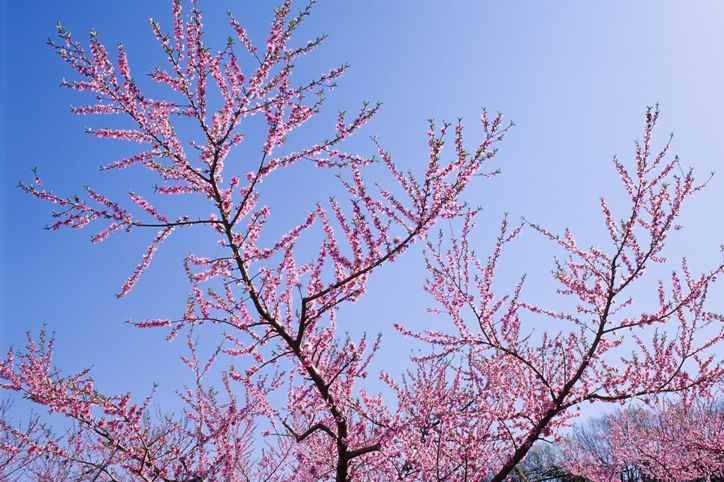
A peach tree in blossom. Chilling hours are important to choosing the right fruit tree for your garden.
Ask yourself several questions before choosing a fruit tree that’s the best for you.
Do you enjoy the pink rosy petals of an apple blossom?
Is apple pie your favorite?
Or, do you prefer figs, peeling back the skin to take a bite of the juicy, red fruit?
Would you prefer a wanderer like blackberry or blueberry that you can stitch through your fence to create a windbreak for your vegetables?
Some fruit trees to consider are apple, apricot, blackberry, blueberry, citrus (satsuma), fig, peach, pear, persimmon, and plum.
Depending on the space you have available, it's important to know if the variety of fruit you choose is self-pollinating. Also, look for the words "no pollination required" or "self-fruitful." If it is not self-pollinating, you will need to plant two.
Next, choose a fruit that meets the area's chilling hours.
CHILLING HOURS
First, a definition is in order. "Chilling hours” is the amount of time the temperature is between 32 degrees and 45 degrees, which is needed to break dormancy and induce normal bloom and vegetative growth. There are exceptions and the years vary, but in a normal year — if there is such a thing — most of the fruit trees in our area are going to experience 600-800 chilling hours.
Fruit trees have a chilling requirement in order to produce the optimum harvest for a given fruit. All fruits don’t have the same requirements for chilling hours. Some are as low as 200-400 hours, while others are as high as 1,000 hours.
When selecting your fruit trees or cane berries (blackberry, blueberry), look at the chilling hour requirements for each tree and realize that if they have a lower requirement, you might run the risk of it blooming too early and being subject to a late freeze. If the requirement is too high, the tree might not do well due to our “usually” mild winters. The best advice is to stay within the designated hours that are normal for the Texas Hill Country (as stated above).
These chilling hours will vary depending on the variety of each fruit you choose.
- Apple — 200-600
- Apricot — 300-1,000
- Blackberry/blueberry — 300-1,000
- Citrus (satsuma) — 300-400
- Fig — 150. But these are hardy trees, worth the gamble if planted close to a structure or receiving passive protection.
- Peach — 400-1,000
- Pear — 200-800
- Persimmon — 200-400
- Plum — 250-600
Let’s pick a peach tree, as an example. How in the world do we choose from so many? Match the chilling hour requirements with the number of chilling hours available and maybe even gamble a bit, choosing from both high and low requirement peach trees.
Next, do you want “cling” or “free” peaches. Those terms refer to the relationship the peach seed (stone) has with the fruit of the peach. When the meat sticks to the seed, it is considered a cling peach. Inversely, when the meat pulls freely away from the seed, it is called freestone or free. It is just a matter of personal preference.
Until next time, keep your souls and soles in your garden!
Remember the True Master Gardener: Jesus said, “I am the vine; my Father is the Gardener.” John 15:1
Contact Bill Luedecke at The Luedecke Group Realtors at 512-577-1463 or email him at bill@texasland.net. Contact daughter Martelle Luedecke at 512-769-3179 or luedeckephotography@gmail.com.












